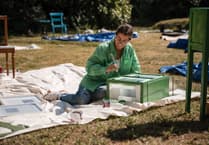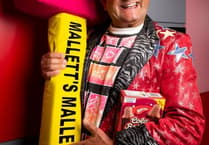Anyone who knows the song The Ugly Duckling will know that the bird in question, when a youngster, was derided by fellow birds for its scruffy brown and grey feathers and told to ’get out of town’, only to transform into a beautiful white adult swan.
Sadly, as the pictures on these page show, in the Isle of Man quite the opposite has happened in the case of Douglas’s seafront centrepiece the Castle Mona Hotel and the grounds which once surrounded it.
Where once there was a grand governor’s mansion of Scottish stone remarked upon for its dazzling whiteness, and surrounded by well-tended lawns and groves of trees, there is now a dirty grey, fenced-off embarrassment of a former hotel, hemmed in by other buildings.
However, the next few months may prove crucial to its future with a couple of rival schemes having been proposed for it by potential buyers and an independent engineer’s report declaring that its internal condition is fairly sound. If these potential buyers fail to reach a deal, however, it is due to be auctioned on July 17 - and what then?
Yet the Castle Mona is not ’just another old hotel’ but one of the nearest things the Isle of Man has to a stately home, dating from the late Georgian era and a former ducal and governor’s residence of innovative design. At the time it was built the idea of building such a grand residence, along with gardens and shrubberies, right on the seashore was something very new.
The Castle Mona’s first occupant, John, 4th Duke of Atholl, became Governor-General of the island in 1793. The original Atholl residence at Port-e-Chee (Manx for ’the Haven of Peace’), close to Old Kirk Braddan, was celebrated for its attractive grounds, so there was much scratching of heads when the Duke announced in 1801 that he was going to have a grander residence built right on the seashore. Nevertheless, the Duke held a tented reception on his proposed mansion site to which he invited many of the island’s well-to-do families.
Designed by the Duke’s Perthshire-born retainer George Steuart, the Castle Mona took three years to build at a cost way over budget and was unveiled at another grand reception attended by the island’s gentry in 1804.
We have looked at the architecture of the castle itself in a previous Buildings at Risk article, so here we will look at the wider estate, which was composed of parcels of land brought by the Duke from various owners and extended from what is now Broadway along the seashore to the foot of Summer Hill and then as far inland as what is now Dukes Road.
It would appear that people were still sceptical about the chances of the Duke’s planned gardens flourishing. In 1811 the visitor George Woods wrote: ’This is a stately edifice, and has none to vie with it upon the island.... It is at present bare of trees; and how far the young Plantations are likely to nourish seems very doubtful’.
Five years later, in her ’History of the Isle of Man’, Hannah Bullock was also critical: ’The domain around the mansion is on a sea of littleness exciting continual astonishment since there could be no cause why the lord, in the whole island, should fix on a spot so circumscribed, that the dwelling appears complete crowded under the hill... The terraces, walks, and gardens, would hardly suffice to exercise the taste of a citizen who had to plan out his parterre and paddock for a country-box at Islington...’.
Clearly she had not reckoned on the benefits to planting of the island’s Gulf Stream climate as when Dorothy Wordsworth, sister of the poet William, visited in 1828 the Castle Mona grounds had become a luxuriant paradise.
She wrote: ’July 5th, Saturday. Very bright morning. Wrote to Mrs H. and then to Duke’s gardens, which are beautiful. I thought of Italian villas, and Italian bays, looking down on a long green lawn adorned with flower-beds... a perfect level, with gravel walks at the sides, woods rising from it up the steeps, and the dashing sea, boats, and ships, and ladies struggling with the wind, veils and gay shawls and waving flounces. The gardens beautifully managed - wild, yet neat enough for plentiful produce. Shrubbery, forest trees, vegetables, flowers, and hot-houses, all connected, yet divided by the form of the ground. Nature and art hand in hand, all shrubs, and Spanish chestnut in great luxuriance.’
It was soon afterwards that the 4th Duke of Atholl’s connection with the Isle of Man came to an end and the Castle Mona was converted to a hotel in 1831, with the noted architect John Welch working on the conversions. The first few hotel owners did not prosper, but when a Dubliner by the name of Heron took over the castle settled down to a period of success.
In the 1841 Quiggin’s Guide notes that board and lodging ’table d’hote’ at Heron’s Castle Mona Hotel cost £2 2s 0d per week but with the island’s visitor industry growing, it was in the 1840s that the first parcels of the estate were sold off for development, probably resulting in the demolition of the twin lodges which once stood at the entrance to the drive. In the area between the former entrance drive and the sea still known as ’Back Lawn’ were built Clarence Terrace, The Esplanade and Derby Terrace.
Blue badge guide and former Isle of Man Natural History and Antiquarian Society president Frank Cowin was brought up in Clarence Terrace and has a particular appreciation for the buildings’ architectural and decorative period features, such as verandas and roof brackets, which can be admired by walking along Castle Mona Avenue, which follows the course of the old estate drive.
He also owns a Castle Mona Estate auction sale brochure from 1888, giving attractively presented artist’s ’aerial views’ of the estate grounds as they then looked, with walks, shrubberies and fountains all carefully drawn, and with vignettes showing the woodland walks and rides which once existed where Empress Drive, Mona Drive and Castle Drive now rise up the coastal escarpment to Upper Douglas.
It was that auction which saw the disappearance of much of the former grounds under development. The Castle Mona was listed in guidebooks as being one of the pricier hotels - room for 3/-, breakfast for 1/-, afternoon tea from 2/6, dinner 3/-, Pension 8/6 per day or 73/6 a week - and the area of beach in front of it was where the more respectable visitors went for their sea bathing: ’Here are drawn up in rows at a respectful distance apart, bathing machines for ladies and gentlemenâ?¦
’They are well constructed and comfortably fitted up; and their tariff - sixpence for one bather, ninepence for two - is reasonable.’
It was therefore inevitable that when the estate land was sold off that others would want to build boarding houses and hotels to attract the visitors who patronised these beach facilities.
Frank Cowin remembers that at the back of Clarence Terrace was a row of stables which in time was occupied by the coach firm Cleggs, which initially operated horsedrawn vehicles to take visitors on outings around the island. His great grandmother and great aunt from time to time booked one to take them on outings to the Injebreck Hotel or Niarbyl. Later the firm ran motor coaches and Frank still has an old photograph of his great grandmother at the Injebreck Hotel on one of these excursions.
Other attractions, such as the original Palace - ’the largest building in Douglas, devoted entirely to amusement in which concerts are held every Sunday during the season. It cost nearly £100,000’ notes the Shilling Guide - encroached on the area close to the Castle Mona. Nearby there was also the Olympia, ’a recent addition to the pleasure and recreational grounds of the town... it is chiefly devoted to athletic sports’.
Development continued right up until the First World War, with 1913 being the peak year for Manx tourism. The summer of 1914 looked set to surpass it but the outbreak of the war saw the boom ending abruptly and the boarding houses lying empty. We hope to cover more of the area’s history in a future Buildings at Risk article.
Now it is the Castle Mona lying empty, having been closed as a hotel and mothballed for a number of years and the pictures accompanying the estate agents’ online sales brochure present a sad contrast with those of the 1888 estate sale brochure.
Ideally it is to be hoped that any purchaser will take note of the building’s important heritage as a registered building constructed in the Georgian era and will take steps to reinstate some of its former splendour and perhaps enhance its landscape setting despite the loss of so much of the surrounding grounds.
Some remarkable 19th century castle restorations have received media attention in recent years, with Cardigan Castle in Wales - consisting of a Regency mansion built within the walls of a medieval castle - being transformed, thanks to a determined community campaign and action by the local council, from a derelict eyesore and embarrassment into a beautifully restored boutique bed and breakfast, heritage centre and restaurant - wining this year’s Channel 4 Great British Buildings Restoration of the Year competition.
A close runner-up in the competition was Lews Castle in Stornoway in the Outer Hebrides. Again a local community campaign and action by the Western Isles Council has seen it magnificently restored as a home for island archives together with a modern restaurant and function rooms which can be hired by community groups and residents for social gatherings and weddings.
True both these schemes have benefited from UK Heritage Lottery funds - something not applicable in the self-governing Isle of Man - but the important role that community and local authority action can play is clear.
Both the potential buyers of the Castle Mona who have shown their hands so far are private individuals or companies.
One, the self-proclaimed ’His Majesty the Sole, King of Moraceae’, real name James Clanton, has written his PhD thesis on the building and wants to make it his base for creating a ’futurist realm’ and ’monarchy of meritocracy’. He says on his Foundation website (moraceae.com) that ’An expert team of local and international advisors have now come together in support of HM’s bid to purchase and develop the Castle Mona into a historic residence and social members club promoting social capital on the island. The Castle Mona is a vital part of Manx and British history and the only palace on the island.’
Another proposal, by the UK-based international investment group the Wild Coast Group, which specialises in retirement properties and has international investors, seeks to make the castle’s restoration part of package to enhance the town and promenades, boosting tourism and helping businesses in the process. This scheme would see Castle Mona being completely refurbished as a top end/private club renamed ’No.1 Castle Mona Place’. In addition there would be 18 flats for sale along with penthouse suites, two dining rooms, lounges, a library and reading room, a coffee lounge and restaurant open to the public, a heritage room about the building’s history and possibly a swimming pool and gym, as well as underground car parking.
In addition, Castle Mona would be returned to an element of its original setting by restoring the gardens at the rear and having the entire front landscaped.
The Isle of Arran white freestone frontages would be cleaned ’by the best historic renovation contractors and architects’ to something close to their original colour and the unsightly newer additions to the hotel demolished and replaced by extensions built in the same style as the original castle and housing 21 further flats’. However, this is all tied in with a hotel and cinema scheme for the Middlemarch site at the corner of Lord Street and Walpole Avenue.
So fingers crossed that there is some result which helps transform the Castle Mona and its surroundings back from being an ugly duckling to a white swan again, while respecting its heritage and making it something of which the island community can be proud and to which all have access.




